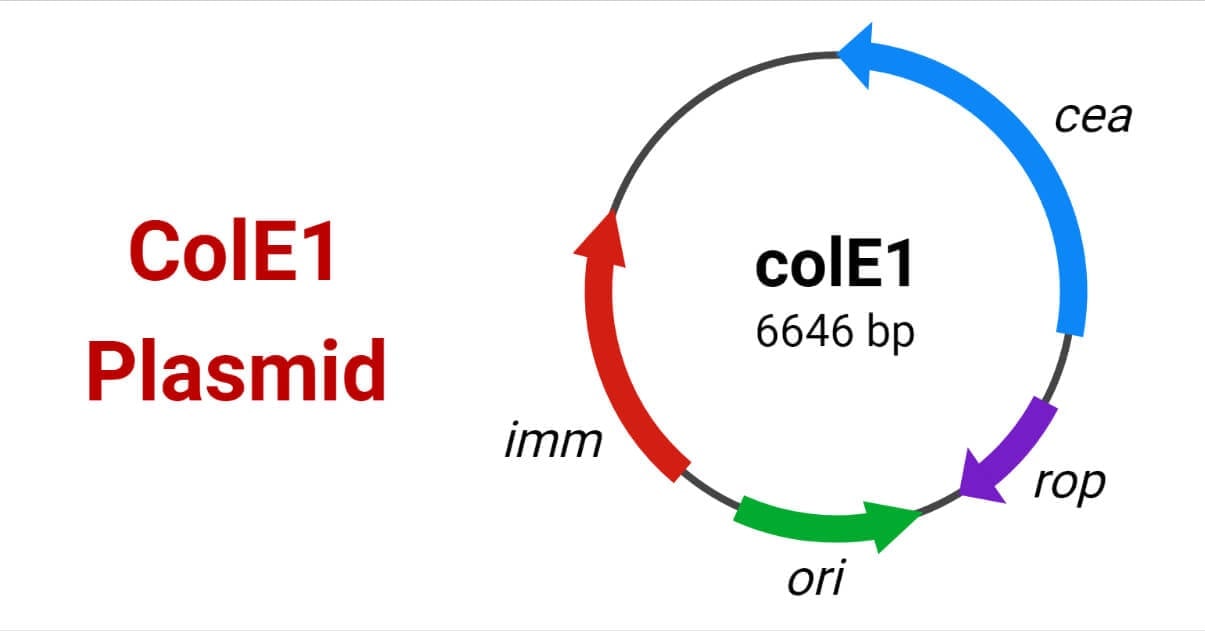The name ColE1 stands for the gene colicin E1. This plasmid is found in bacteria E. coli. It is a naturally occurring plasmid in bacteria.
ColE1 plasmid belongs to the family of bacteriocins. It is a relaxed plasmid, which means it has multiple copy numbers (many copies per cell). It is 6646 bp long, circular, and closed plasmid.
It produces colicin E1. It is a non-conjugative plasmid (it cannot be transferred from one bacterial cell to another through the pilus) as it lacks the genes required for conjugation. In the ColE1 plasmid, the replication process is controlled by an antisense RNA molecule.
Interesting Science Videos
Structure of ColE1 Plasmid
- It is a small, closed circular plasmid.
- The molecular weight of the ColE1 plasmid is 4.2×106 Da and is 6646 bp in length.
- It lacks mob gene (mobility genes) and bom sequence (basis of mobility), and hence, it cannot complete the transmission independently.
- It contains the gene colicin E1, which produces bacteriocin. It also codes for immunity against bacteriocin with the imm gene.

Origin of replication
- The origin of replication of the ColE1 plasmid lies in about 1 kb region. It is found 555 bp downstream of the RNA II start point.
- The ColE1 plasmids replicate through the process of the theta-type mechanism.
- The replication process is unidirectional.
Restriction sites
- The restriction enzyme EcoR1 cleaves the ColE1 plasmid at a unique site.
- EcoR1 cleaves the DNA strands at the 5` GAATTC 3` site.
Advantages of ColE1 Plasmid
- ColE1 is a basis for many artificial vectors used in the cloning process.
- ColE1 plasmids are resistant to a wide range of antibiotics which makes these plasmids a great tool in genetic engineering.
- The colicin genes are replaced by antibiotic resistance genes for industrial purposes.
- The resistance genes in the host bacteria allow them to escape the effect of the bacteriocin.
- The transmembrane protein Colicin E1 causes lethal membrane depolarization in bacteria.
References
- https://www.frontiersin.org/articles/10.3389/fbioe.2015.00127/full
- del Solar, G., et al. (1998). Replication and control of circular bacterial plasmids. Microbiology and molecular biology reviews : MMBR, 62(2), 434–464. https://doi.org/10.1128/MMBR.62.2.434-464.1998
- https://www.sciencedirect.com/topics/biochemistry-genetics-and-molecular-biology/cole1
- https://www.sciencedirect.com/topics/medicine-and-dentistry/colicin-factor
- OKA, A., TAKANAMI, M. Cleavage map of colicin E1 plasmid. Nature 264, 193–196 (1976). https://doi.org/10.1038/264193a0
- Hershfield, V et al. (1974). Plasmid ColEl as a molecular vehicle for cloning and amplification of DNA. Proceedings of the National Academy of Sciences of the United States of America, 71(9), 3455–3459. https://doi.org/10.1073/pnas.71.9.3455
- Ares-Arroyo et al. (2018). PCR-Based Analysis of ColE1 Plasmids in Clinical Isolates and Metagenomic Samples Reveals Their Importance as Gene Capture Platforms. Frontiers in Microbiology. 9. 469. 10.3389/fmicb.2018.00469.
